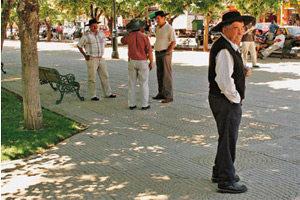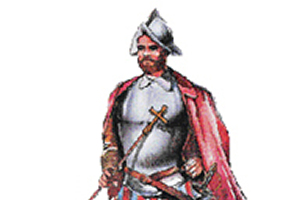This region’s climatic conditions and fertile soils favour the agricultural activities, and very especially wine growing.
Besides, the region’s important hydro electrical plants help the economical growth.
Agriculture
Grape is the region’s main farming, the table one as well as the one used in the wine production. Accordingly to the latter, Maule is the region concentrating the greatest surfaces of vineyards with 51.058,6 hectares, out of which 744, 1 are table grape and 50.314,5 are for wine production.
According to the Servicio Agricola Ganadero (SAG) statistics, in 2007 the wine regional production was of 404.604.103 liters and the main regional vines are: Cabernet Sauvignon, País, Merlot, Sauvignon Blanc, Carménére, Syrah, Carignan, Cot, Torontel, etc.
Another important fruit production is apples, which according to the 2007 Farming Census is near the 60% of the national plantations. The most common regional varieties are the Royal Gala, Red Chief, Fuji, Scarlet and Braeburn. These are exported to the United States and countries of the European Union.
Other important fruit plantations are kiwis, pears and cherries.
In the cereal, tubercles and legumes area stands out wheat, corn, rice, potatoes and beans.
Is worth emphasizing that rice is highly important since the 78% of the national production concentrates in the province of Linares.
Beetroot is an industrial farming that has grown considerably in the last years. During the period 2006-2007 the sown surface of this product was 6.900 hectares.
Forestry and Cattle sectors
According to CONAF, there are in these region approximately 920.000 hectares of forests, out of which 800.00 belong to forestry plantations (industrial) and the rest to native woods.
Regarding forest plantations, these comprise near the 25% of the national total. The main species are Pino insigne (Pinus radiate) with 287.004 hectares and Eucalyptus (Eucalyptus globulus) with 22.145 hectares concentrated in Cauquenes, Constitución and Empedrado. All of these are used for cellulose elaboration and sawn wood.
Cattle rising are mainly bovine representing almost the 10% of the national total concentrating a great deal of its production to the meat area.
According to the Bovine Cattle Rising Study done by INE in 2005, the region had 196.669 bovines, out of which 70.358 were steers; 53.304 were cows ( 4.000 were for milk production concentrating at the Linares zone); 40.442 were calves and young cows; 30.459 were heifers; 1.849 were bulls and 257 were ox. The latter were mainly in the province of Curico.
Fishing
Fishing is given mainly at a crafty regional level (covering the 97% of the regional fishing sector) and for self consumption. According to data from Sernapesca (Fishing National Service) there are 350 ships extracting fish and mollusks. The main fishing resorts are Duao, Llico, Putu, Los Pellines, Cardonal, Loanco, Curanipe,, Pelluhue and Constitucion.
The 2006-2010 Regional Governmental Plan established that the main difficulties for the industrial development of this sector is the coast’s progressive embankment, the extraction of some species with conservation problems, heavy metal contamination and other waste disposed off to the sea.
Power
The region of Maule has eleven hydro electrical as well as thermo electrical plants. Among the hydro electrical plants are three from the following enterprises: Colbun (Machicura, San Ignacio and Colbun), other two are from Endesa (Cipreses and Isla) and the last three ones (Pehuenche, Curillinque and Loma Alta) belong to the Pehuenche enterprise.
Meanwhile, only three thermo electrical plants function in this zone. Celco and Licanten, since 1996 and 2004, respectively, and they belong to Arauco Generacion enterprise, and Constitucion belongs to Energía Verde.
According to the INE Power Yearbook (2006), this region generated 10.235 GW/h (gig watts per hour). Out of which, 9.881 GW/h correspond to hydraulic power and 354 GW/h to thermal power.
Due to this fact, this is the second region producing more power in the country after the region of BioBio.
Human geography
According to the 2002 census, the population’s 66, 4% lives in urban zones and 33, 6% in rural areas. The latter is the country’s highest index of rural life since it is over the national average, that is 13, 4%.
Regarding the inter census period growth, the comuna (county) of Maule is the one that grew most between 1992 and 2002, with a 22.333%; followed by Talca with a 17,7%; Pelluhue with a 17,2% and Curico with a 14,9%.
Concerning the region’s gender composition, the information points out that 50, 1% (455.109) of the population are women and that 49, 9% (452.988) are men.
In the educational ambiance, this region has 825 educational establishments forming 219.259 students at the pre basic, basic and intermediate levels. This belongs to the 6, 1% of the national total.
According to the 2006-2010 Regional Governmental Plan, the population’s average education is the lowest in the country, since it only reaches the 8, 5 years of age while 9, 5 is the national level. This is also reflected in the high rate of illiteracy that in this region is of up to an 11, 6%.
According to the 2002 Census, the indigenous population inhabiting this zone is 8.557 inhabitants, out of which the majority belongs to the mapuche ethnic group (8.134 persons).








